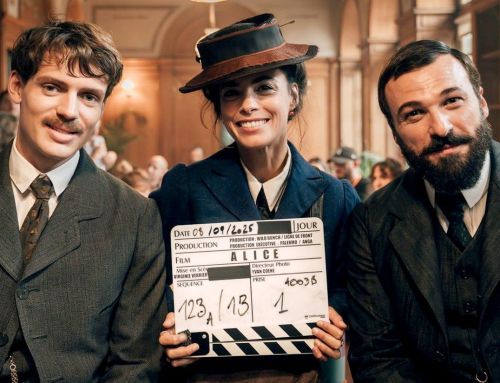With “Mary Shelley,” Woman Behind Monster Directed by Woman Behind Camera
There were many films at the Tribeca Festival, many about women, and many others directed by women. “Mary Shelley,” starring Elle Fanning, is not only both, but perhaps was one of the best films at this year’s Tribeca Festival, which ended recently. As the title suggests, “Mary Shelley” tells the story of the nineteenth century-author who penned the horror classic “Frankenstein.” And in a case of irony as poetic as the main character’s husband Percy Shelley, the film about a historic woman is directed by a woman who made history. Haifaa Al-Mansour (“Wadjda”) is the first female filmmaker from Saudi Arabia. Even more curiously, the film about the creator of Frankenstein makes its debut at a festival created by the actor who starred in 1994’s “Mary Shelley’s Frankenstein.”
The idea of the woman behind the monster is an interesting twist on previous incarnations, which usually explain the tale from the perspective of the fictitious male characters. We’ve heard from Dr. Frankenstein, but what about the woman who wrote him? Shelley’s side alone would be thought-provoking, but seeing it through the eyes of a female director adds even more depth, especially one who, like Shelley, overcame the odds in making her creative mark in a male-dominated society.
Although “Mary Shelley” explores the author’s early life, including her relationship with “Percy,” the film is not just about their love and marriage. During my encounter with the filmmaker at Triebeca, Al-Mansour explained, “it’s about philosophy and questioning life and in her case, creating life. Her determination in pushing forward is a great legacy to women and a great example to celebrate.”
Al-Mansour, a literature major in college, was quite familiar with Shelley’s work and was sent the script because producers felt the theme of the story, and what Mary went through, are specific to the experiences of women. Al-Mansour added “I’m sure they looked at other directors, but I think my passion for the character prevailed.”
Research for the film including reading biographies of Shelley and the Frankenstein novel. But Al-Mansour believes that what really helped was reading actual letters sent between Mary and Percy while they were living apart. “They really told me who they were and, despite all their problems, showed me the calmness of their relationship.”
The film begins in London in the early 1800s, when we meet teenager Mary Wollstonecraft Godwin (named after her late mother). She is living a traditional and meager life with her father William, her stepsister Claire and Mary Jane, her step-mother. The latter of which is a strained relationship. As young Mary rumbles around her father’s bookstore she constantly scribbles in a notepad while dreaming of one day becoming a writer. She eventually meets and starts an affair with a dashing poet named Percy Shelley. The pair quickly marries and begins traveling through Europe, during which Mary experiences the loss of a baby, an incident that forever changes her as well as her outlook on creation, itself. They wind up spending a summer in Geneva, Switzerland at the home of Lord Byron, who has started an affair with Claire. It is here, on a dreary night, that Byron suggests they each write a ghost story. Engrossed by her interest in science and burdened by the memory of her lost baby, Shelley pens a tale of great interest.
One of the film’s qualities is a tightly-devised script by Emma Jensen, one that, like some period pieces, does not get bogged down in exposition with over-the-top period dialogue. Another is the many exotic locations. “We shot in Ireland, Luxembourg and France.”
Of course, directing a period piece has its own set of challenges but Al-Mansour credits a great team of art designers in helping create the era. Making a film about people who really existed had its limitations, however. “Mostly everyone knows the story of Frankenstein so there was a lot of concentration to be true to the essence of the characters, so bringing the heart and soul of who they were was a real challenge.”
Obviously, Al-Mansour succeeded: the characters of “Mary Shelley” drive the story instead of getting lost in esthetic detail and vintage sets, as is often the case with period pieces. In addition, they graciously navigate through the film in a way that gives even the tried-and-true Frankenstein buffs the patience to see the actual monster that they’re subconsciously thinking about. It should be noted that the actual reveal of Shelley’s creation is done in a subtle yet satisfying way. Great performances by Douglas Booth (“The Riot Club”) as “Percy,” Bel Powley (“The Diary of a Teenage Girl”) as “Claire Clairmont,” Tom Sturridge (“Effie Gray”) as “Lord Byron,” Stephen Dillane (“Darkest Hour”) as “William Godwin” and of course Elle Fanning (“The Beguiled”) as “Mary,” are the cherry on the cake.
As far as casting Elle Fanning, Al-Mansour told me, “She was looking for more adult roles, but she still retained the youthful look which was important in showing how young Mary was at this time.” She added “Elle had an elegance and energy that really captured the character.”
Regarding the label of “female” director as opposed to just “director” Al-Mansour surprisingly replied, “I like the term female director, I’m very proud of my femininity.” I’m sure Mary Shelley was, as well. No doubt the gothic writer would be equally proud of Al-Mansour’s film.
“Mary Shelley” opens in theaters May 25th.








